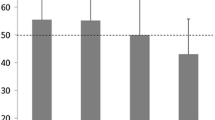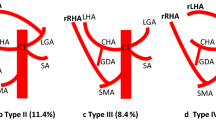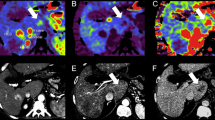Abstract
Introduction
Transient hepatic attenuation differences (THAD) are areas of high parenchymal enhancement observed during the hepatic arterial phase on computed tomography (CT). THAD in the left lobe of the liver can lead to surgical complications.
Methods
A retrospective study was conducted on patients who underwent multislice computed tomography (MSCT) examination of the upper abdomen to understand the morphology, distribution, and causes of THAD and their correlation with hepatic artery variation.
Results
Among 179 cases, 65 and 114 belonged to diseased and normal groups, respectively. THAD as observed in MSCT demonstrated various shapes: lobe/segment (127 cases; 70.9%), irregular sheet (31; 17.3%), strip shape (9; 5.02%), arc/semicircle (7; 3.9%), and segment + flaky (5; 2.79%). THAD were found to be caused by liver tumor (32.3%), hepatic inflammatory lesions (6.15%), biliary tract diseases (13.8%), perihepatic disease compression (9.23%), portal vein obstructive disease (1.53%), and lesion in left hepatic lobe with hepatic artery variation (29.2%). THAD exhibited variation in distribution in the left lobe of the liver. Among 114 cases, THAD in 18 (15.7%) cases were observed in the S2 segment, six (5.26%) in the S3 segment, and 90 (78.9%) in multiple segments of the liver, that is, 50 cases in S2 and S3 segments and 40 cases in S2, S3, and S4 segments. The hepatic artery of 179 cases was of various types based on Hiatt classification: 57 cases of Hiatt I (31%), 65 cases of Hiatt II (37%), 11 cases of Hiatt III (6%), 17 cases of Hiatt IV (10%), 7 cases of Hiatt V (4%), 12 cases of large left hepatic artery (7%), 6 cases of right hepatic artery originating from the celiac trunk (3%), and 4 cases (2%) of superior mesenteric artery originating from the celiac trunk.
Conclusion
THAD can occur as a result of specific pathological causes and hence should be considered as a diagnostic sign in liver pathologies.


Similar content being viewed by others
References
Wong H, Desser TS, Jeffrey RB. Transient hepatic attenuation differences in computed tomography from extrahepatic portal vein compression. Radiol Case Rep. 2015;3. https://www.ncbi.nlm.nih.gov/pmc/articles/PMC4896106/
Kim HJ, Kim AY, Kim TK, et al. Transient hepatic attenuation differences in focal hepatic lesions: dynamic CT features. Am J Roentgenol. 2005;184:83–90.
Zhou X, Luo Y, Peng Y-L, et al. Hepatic perfusion disorder associated with focal liver lesions: contrast-enhanced US patterns—correlation study with contrast-enhanced CT. Radiology. 2011;260:274–81.
Bin Y, Key YC, et al. Correlation between transient perfusion abnormality of left hepatic lobe and MSCT of hepatic artery variability. Chin J Med Imaging. 2017;23:412–7.
Quiroga S, Sebastià C, Pallisa E, Castellà E, Pérez-Lafuente M, Alvarez-Castells A. Improved diagnosis of hepatic perfusion disorders: value of hepatic arterial phase imaging during helical CT. Radiographics. 2001;21:65–81 (questionnaire 288-294).
Colagrande S, Centi N, Galdiero R, Ragozzino A. Transient hepatic intensity differences: part 2, those not associated with focal lesions. AJR Am J Roentgenol. 2007;188:160–6.
Colagrande S, Centi N, Galdiero R, Ragozzino A. Transient hepatic intensity differences: Part 1, those associated with focal lesions. Am J Roentgenol. 2007;188:154–9.
Hwang J, Kim SH, Lee MW, Lee JY. Small (≤2 cm) hepatocellular carcinoma in patients with chronic liver disease: comparison of gadoxetic acid-enhanced 3.0 T MRI and multiphasic 64-multirow detector CT. Br J Radiol. 2012;85:e314–e322322.
Iannaccone R, Laghi A, Catalano C, et al. Hepatocellular carcinoma: role of unenhanced and delayed phase multi-detector row helical CT in patients with cirrhosis. Radiology. 2005;234:460–7.
Köseoğlu K, Taşkin F, Ozsunar Y, Cildağ B, Karaman C. Transient hepatic attenuation differences at biphasic spiral CT examinations. Diagn Interv Radiol. 2005;11:96–101.
Ugurel MS, Battal B, Bozlar U, et al. Anatomical variations of hepatic arterial system, coeliac trunk and renal arteries: an analysis with multidetector CT angiography. Br J Radiol. 2010;83:661–7.
Thangarajah A, Parthasarathy R. Celiac axis, common hepatic and hepatic artery variants as evidenced on MDCT angiography in South Indian population. J Clin Diagn Res. 2016;10:TC01–5.
Hiatt JR, Gabbay J, Busuttil RW. Surgical anatomy of the hepatic arteries in 1000 cases. Ann Surg. 1994;220:50–2.
Cao Q-Y, Zou Z-M, Wang Q, He C-N, Zou Q, Wang B. MRI manifestations of hepatic perfusion disorders. Exp Ther Med. 2018;15:5199–204.
Tian J-L, Zhang J-S. Hepatic perfusion disorders: etiopathogenesis and related diseases. World J Gastroenterol. 2006;12:3265–70.
Hwang SH, Yu J-S, Chung J, Chung J-J, Kim JH, Kim KW. Transient hepatic attenuation difference (THAD) following transcatheter arterial chemoembolization for hepatic malignancy: changes on serial CT examinations. Eur Radiol. 2008;18:1596–603.
Yamashita K, Jin MJ, Hirose Y, et al. CT finding of transient focal increased attenuation of the liver adjacent to the gallbladder in acute cholecystitis. AJR Am J Roentgenol. 1995;164:343–6.
Choi BI, Lee KH, Han JK, Lee JM. Hepatic arterioportal shunts: dynamic CT and MR features. Korean J Radiol. 2002;3:1–15.
Lee SJ, Lim JH, Lee WJ, Lim HK, Choo SW, Choo IW. Transient subsegmental hepatic parenchymal enhancement on dynamic CT: a sign of postbiopsy arterioportal shunt. J Comput Assist Tomogr. 1997;21:355–60.
Ravikumar H, Singh J, Kalyanpur A. Transient hepatic attenuation difference (THAD)—a case report. Indian J Radiol Imaging. 2006;16:441.
Eipel C, Abshagen K, Vollmar B. Regulation of hepatic blood flow: the hepatic arterial buffer response revisited. World J Gastroenterol. 2010;16:6046–57.
Noussios G, Dimitriou I, Chatzis I, Katsourakis A. The main anatomic variations of the hepatic artery and their importance in surgical practice: review of the literature. J Clin Med Res. 2017;9:248–52.
Desser TS. Understanding transient hepatic attenuation differences. Semin Ultrasound CT MR. 2009;30:408–17.
Wong H, Desser TS, Jeffrey RB. Transient hepatic attenuation differences in computed tomography from extrahepatic portal vein compression. Radiol Case Rep. 2008;3:113.
Soin AS, Friend PJ, Rasmussen A, et al. Donor arterial variations in liver transplantation: management and outcome of 527 consecutive grafts. Br J Surg. 1996;83:637–41.
Colagrande S, Pradella S, Lucarini S, Marra F. Transient hepatic parenchymal enhancement detected at dynamic imaging: a short instruction manual for the clinician. Dig Liver Dis. 2012;44:363–8.
López-Andújar R, Moya A, Montalvá E, et al. Lessons learned from anatomic variants of the hepatic artery in 1,081 transplanted livers. Liver Transpl. 2007;13:1401–4.
Michels NA. Newer anatomy of the liver and its variant blood supply and collateral circulation. Am J Surg. 1966;112:337–47.
Lhuaire M, Tonnelet R, Renard Y, et al. Developmental anatomy of the liver from computerized three-dimensional reconstructions of four human embryos (from Carnegie stage 14 to 23). Ann Anat. 2015;200:105–13.
Németh K, Deshpande R, Máthé Z, et al. Extrahepatic arteries of the human liver—anatomical variants and surgical relevancies. Transpl Int. 2015;28:1216–26.
Acknowledgements
We thank the participants of the study
Funding
No funding or sponsorship was received for this study or for the publication of this article. The Rapid Service Fee was funded by the authors.
Editorial Assistance
Vedashree Sobagaiah from Indegene provided editorial assistance comprising English editing and submission assistance. This assistance was funded by the authors.
Authorship
All named authors meet the International Committee of Medical Journal Editors (ICMJE) criteria for authorship for this article, take responsibility for the integrity of the work as a whole, and have given their approval for this version to be published.
Authorship Contributions
Conception of the study: Jian Guan & Guangyan Si; Fei Yu, Rong Xian, and Jie Zhang contributed significantly to analysis and manuscript preparation; Bin Yang performed data analyses and wrote the manuscript; Qizhou He, Shulan Liu, and Sikan Wang performed the analysis with constructive discussions.
Disclosures
Bin Yang, Guangyan Si, Qizhou He, Shulan Liu, Sikai Wang, Rong Xian, Jie Zhang, Fei Yu, and Jian Guan have nothing to disclose.
Compliance with Ethics Guidelines
The study was approved by the Affiliated Traditional Chinese Medicine Hospital of Southwest Medical University Ethics Committee (TCMH-SMU-287) and was performed in accordance with the Declaration of Helsinki and its amendments. All patients included in the study gave informed consent.
Data Availability
The data sets generated and/or analyzed during the current study are available from the corresponding author on reasonable request.
Author information
Authors and Affiliations
Corresponding author
Additional information
Digital Features
To view digital features for this article go to https://doi.org/10.6084/m9.figshare.12563798.
Electronic supplementary material
Below is the link to the electronic supplementary material.
Rights and permissions
About this article
Cite this article
Yang, B., Si, G., He, Q. et al. Multislice Computed Tomographic Manifestation of Transient Hepatic Attenuation Difference in the Left Lobe of the Liver: A Retrospective Study. Adv Ther 37, 3954–3966 (2020). https://doi.org/10.1007/s12325-020-01428-5
Received:
Published:
Issue Date:
DOI: https://doi.org/10.1007/s12325-020-01428-5




